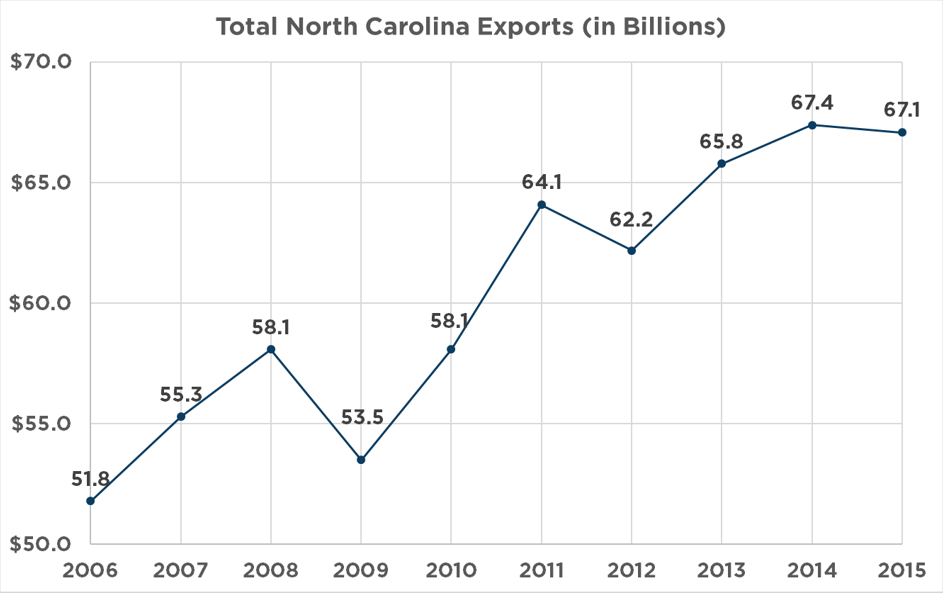By Jamie McCall, Research Analyst at EDPNC
In celebration of World Trade Month, we’re taking a look at how North Carolina businesses are contributing to the global economy.
Before getting into the list, I’d like to quickly note the methodology behind this data series. There are two widely-used sources of export data. First, the Census Bureau offers a measure of exports by state. Census data measures all exports of goods that begin their journey to a foreign market through a port. Second, the Brookings Export Monitor estimates exports of goods and services by production location using economic models. Neither source is incorrect, they simply measure exports in different ways. We use the later source here, so the below numbers reflect all goods and services made in North Carolina which are then exported to other markets. All dollar values are expressed in terms of 2015 dollars (the latest year for which data is available) adjusting for inflation.
Reason 1: North Carolina businesses manufactured and exported over $67.1B worth of goods and services in 2015.
In terms of total export value, that ranks #9 out of the 50 states and the District of Columbia. In the past decade, export values of goods and services have increased +64%. Export values declined -0.6% from 2014 to 2015, but North Carolina still ranks #3 in the region for export change in the past year. Looking over the longer-term, export trends are positive: up +4.6% in the past 5 years and +29.5% in the past 10 years.

Reason 2: North Carolina’s exports play a large role in the state’s total economic output.
About 14% of the state’s total economic output is attributable to goods and services exported by North Carolina businesses. Since 2006, the role of export’s in the state’s total economic output has grown 21%. North Carolina ranks #4 in the southeastern region for export growth as a share of the state’s gross domestic product.
Reason 3: North Carolina’s robust export economy creates hundreds of thousands of jobs.
Over 177,000 jobs are directly attributable to exports. The state ranks #1 regionally and #7 nationally in in terms of the number of jobs supported by exports.
Reason 4: The largest exporting industry in North Carolina is manufacturing.
In 2015, manufacturing businesses in the state exported $49.1B of goods and services, or 73% of North Carolina’s total exports.
| Industry | 2015 Total Exports (in millions) |
Percent |
| Agriculture, Forestry, & Fishing | 2,008 | 3.0% |
| Education, Medical, & Tourism | 3,946 | 5.9% |
| Engineering & Heavy Industry | 2,094 | 3.1% |
| Finance & Insurance | 2,649 | 4.0% |
| General Business Services | 1,536 | 2.3% |
| Information & Technology | 5,545 | 8.3% |
| Manufacturing | 49,127 | 73.3% |
| Mining, Oil, & Gas Extraction | 130 | 0.2% |
Reason 5: Like many other states, urban counties produce the largest share of North Carolina’s exports, but rural counties aren’t far behind.
Urban counties exported $42.2B in 2015, up 34% in 10 years. But North Carolina’s rural counties are also an export powerhouse, contributing an impressive $24.9B to the state’s economy in 2015. Rural exports have increased +22% in the past 10 years.

About the Author
 Jamie McCall is a Research Analyst at the Economic Development Partnership of North Carolina. He attended the University of North Carolina at Pembroke where he earned degrees in Political Science and Philosophy. After college, he attended graduate school at the University of North Carolina at Chapel Hill’s School of Government, where he received a Master of Public Administration degree.
Jamie McCall is a Research Analyst at the Economic Development Partnership of North Carolina. He attended the University of North Carolina at Pembroke where he earned degrees in Political Science and Philosophy. After college, he attended graduate school at the University of North Carolina at Chapel Hill’s School of Government, where he received a Master of Public Administration degree.
Prior to EDPNC, Jamie worked in grant-funded research. His previous roles involved conducting research on a variety of economic development topics like: the influence of social capital, use of eminent domain, urban development, and ecotourism. His work has appeared in multiple peer-reviewed outlets like Public Administration Review, Economic Development Quarterly, and Social Science Quarterly.
Born and raised in North Carolina, Jamie has a passion for using data to better inform economic-development decisions. Much to his colleagues’ chagrin, he also has an appreciation for quality economic development memes. Have a question about some of the data in this post? Tweet to Jamie @JamieEDPNC

